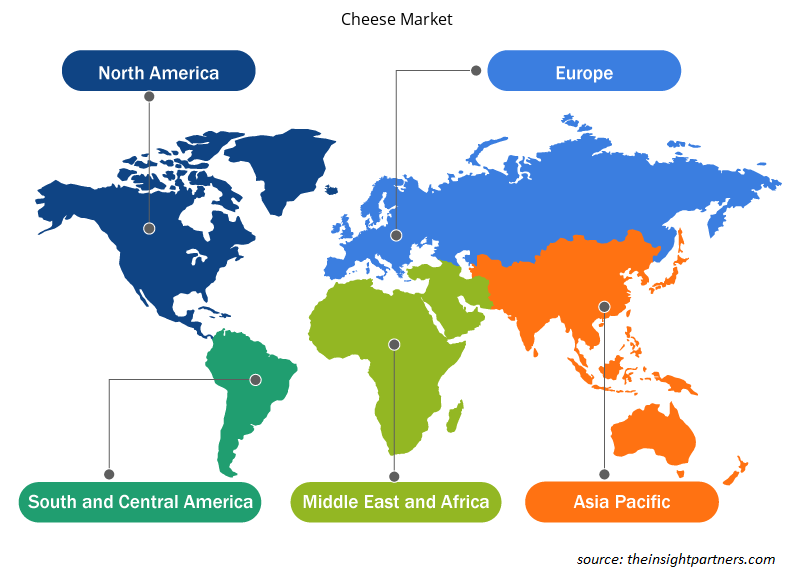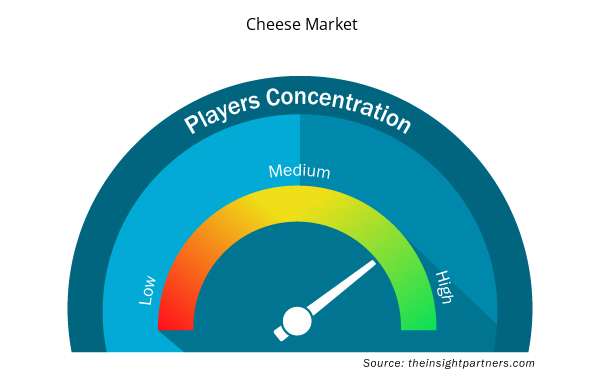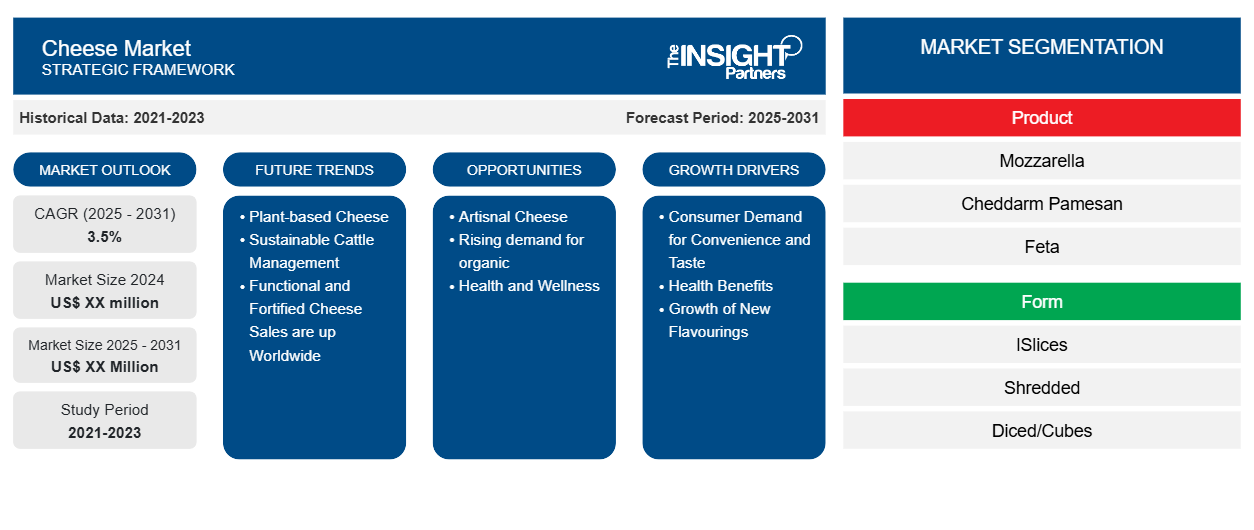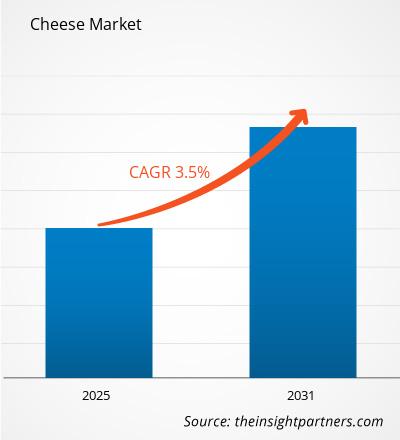Se espera que el mercado del queso registre una CAGR del 3,5 % entre 2023 y 2031, con un tamaño de mercado que se expandirá de US$ XX millones en 2023 a US$ XX millones en 2031.
El informe de investigación de mercado del queso incluye el escenario actual y futuro del mercado, con los impulsores relevantes que afectan al mercado. Este informe se segmenta aún más en subsegmentos según el tipo de queso: Cheddar, Mozzarella, Parmesano, Queso Crema, Feta y Otros. Analiza además el mercado en función de las áreas de aplicación, como la industria de alimentos y bebidas, el consumo doméstico, el sector de servicios de alimentos y otros.
El análisis global se divide además en mercados importantes a nivel regional, que incluyen América del Norte, Europa, Asia-Pacífico, América Latina y Oriente Medio y África. La segmentación por región permite a las partes interesadas comprender las tendencias y las oportunidades de crecimiento en el comportamiento del consumidor y por país, lo que ayuda a comprender las tendencias regionales y las oportunidades de crecimiento. La investigación de mercado se informa en dólares estadounidenses (US$) para el análisis segmentario mencionado anteriormente con el fin de proporcionar el tamaño del mercado, las vías de crecimiento y la predicción.
Propósito del Informe
El informe Cheese Market de The Insight Partners tiene como objetivo describir el panorama actual y el crecimiento futuro, los principales factores impulsores, los desafíos y las oportunidades. Esto proporcionará información a diversas partes interesadas del negocio, como:
- Proveedores/fabricantes de tecnología: Para comprender la dinámica cambiante del mercado y conocer las oportunidades potenciales de crecimiento, lo que les permitirá tomar decisiones estratégicas informadas.
- Inversionistas: Realizar un análisis exhaustivo de tendencias sobre la tasa de crecimiento del mercado, las proyecciones financieras del mercado y las oportunidades que existen en toda la cadena de valor.
- Órganos reguladores: Regular las políticas y vigilar las actividades del mercado con el objetivo de minimizar los abusos, preservar la confianza de los inversores y defender la integridad y estabilidad del mercado.
Segmentación del mercado del queso
Producto
- queso Mozzarella
- Queso cheddar y pamesano
- Queso feta
- Queso azul
- Otros
Forma
- lRebanadas
- Triturado
- Dados/cubos
- Spreads
- Otros
Canal de distribución
- Supermercados e hipermercados
- Tiendas de conveniencia
Geografía
- América del norte
- Europa
- Asia-Pacífico
- América del Sur y Central
- Oriente Medio y África
Geografía
- América del norte
- Europa
- Asia-Pacífico
- América del Sur y Central
- Oriente Medio y África
Personalice este informe según sus necesidades
Obtendrá personalización en cualquier informe, sin cargo, incluidas partes de este informe o análisis a nivel de país, paquete de datos de Excel, así como también grandes ofertas y descuentos para empresas emergentes y universidades.
- Obtenga las principales tendencias clave del mercado de este informe.Esta muestra GRATUITA incluirá análisis de datos, desde tendencias del mercado hasta estimaciones y pronósticos.
Factores impulsores del crecimiento del mercado del queso
- Demanda de los consumidores por conveniencia y sabor: Existen varios factores que impulsan el mercado mundial del queso, pero quizás uno de los factores más importantes que impulsa el consumo de queso en todo el mundo es la demanda de los consumidores por conveniencia, nutrición y sabor. Más específicamente, la creciente demanda en los mercados de comida rápida, comida lista para comer y comida para llevar lo convierte en un factor importante, ya que el queso a menudo ocupa un lugar central. La industria de la comida rápida, que representó más de 690 mil millones de dólares en 2021, sigue creciendo, especialmente en espacios urbanos, lo que aumenta la demanda de varios tipos de queso, como mozzarella, cheddar y queso procesado. Los restaurantes de comida rápida se han convertido en un catalizador importante para la demanda mundial de queso, especialmente en las economías desarrolladas.
- Beneficios para la salud: Dado que el queso contiene algunos aminoácidos que son esenciales para que el cuerpo los utilice en la reparación y el crecimiento de los músculos, no es de extrañar que algunos consumidores que buscan dietas ricas en proteínas ahora consideren que el queso es una opción valiosa. La Federación Internacional de Lácteos (FID) informa que el consumo mundial medio per cápita de queso ha aumentado hasta los 6,5 kg en 2022 y ha impulsado este cambio hacia una mayor conciencia de la salud. Los consumidores quieren quesos más saludables, como variedades bajas en grasas y sodio, que ahora son cada vez más populares en el mercado.
- Crecimiento de nuevos sabores: los productos de queso artesanal y de especialidad también son impulsores del crecimiento del mercado del queso. Ahora, las tendencias del mercado del queso apuntan hacia el consumo de nuevos sabores y diferentes tipos de queso por parte de los consumidores. El feta, el gouda y el queso azul son algunos de los quesos que están ganando terreno más allá de los mercados tradicionales, impulsados por las cocinas globales cuya influencia está en aumento. Europa sigue siendo el mercado más grande para los productores de queso artesanal, con Francia e Italia entre los más grandes. Según la Asociación Europea de Lácteos, en 2020, las ventas de queso artesanal representaron alrededor del 16% de la participación total del mercado del queso en Europa.
Tendencias futuras del mercado del queso
- Queso de origen vegetal: Otra tendencia que está ganando impulso es la demanda de alternativas de queso de origen vegetal, que no hará más que crecer a medida que más personas tomen conciencia del veganismo y la intolerancia a la lactosa. El mercado mundial de queso de origen vegetal asciende a aproximadamente 1200 millones de dólares y se encamina a un enorme crecimiento en el futuro cercano. Algunos líderes que están siendo innovadores en este ámbito son Daiya, Violife y Follow Your Heart. Otra tendencia importante del mercado del queso es la sostenibilidad. América del Norte y Europa suelen estar más desarrolladas en este sentido, ya que hay un aumento de los flexitarianos, es decir, se ha reducido significativamente el consumo de productos de origen animal.
- Gestión sostenible del ganado: Una segunda tendencia clave que está dando forma al mercado del queso es la sostenibilidad. La conciencia medioambiental lleva a los productores lácteos a una agricultura y una producción cada vez más sostenibles. Las empresas están buscando formas de reducir su huella de carbono mediante una mejor gestión del ganado, el ahorro de agua y la promoción de la agricultura regenerativa. Por ejemplo, la empresa danesa Arla Foods pretende reducir la huella de carbono en un 30 por ciento por kilogramo de leche y, en su lugar, cambiará su enfoque hacia una producción de queso más ecológica para 2030. Existe una tendencia creciente hacia los envases sostenibles. Un número cada vez mayor de productores utilizan materiales reciclables o biodegradables porque los consumidores demandan cada vez más productos ecológicos.
- Las ventas de queso funcional y fortificado aumentan en todo el mundo: ahora, los consumidores preocupados por su salud demandan productos de queso más ricos en probióticos, vitaminas y minerales para ayudarlos a proteger su sistema inmunológico y mejorar la salud intestinal, por lo que la demanda ha aumentado significativamente recientemente. Según un estudio publicado en Journal of Dairy Science en 2022, el queso con infusión de probióticos mejora la salud digestiva, lo que ha provocado un cambio al alza en la demanda de este tipo de productos de queso. Las empresas están innovando al agregar ingredientes que mejoran la salud, como los ácidos grasos omega-3 y el calcio, para obtener una ventaja en la respuesta del consumidor a los alimentos funcionales.
Oportunidades en el mercado del queso
- Queso artesanal: Los fabricantes de quesos artesanales y especiales pueden sacar el máximo provecho de esta tendencia lanzando quesos artesanales de edición limitada con sabores exclusivos de una región.
- Demanda creciente de productos orgánicos: el creciente interés por los productos orgánicos está impulsando una vez más la producción en mayor medida, ya que los consumidores están dispuestos a pagar más por queso de origen sostenible y libre de aditivos artificiales. Mercados como Estados Unidos y Europa adoptan posiciones especialmente firmes en esta tendencia de valorar la autenticidad, la calidad y la historia detrás de los alimentos. Los analistas de mercado dicen que el mercado mundial de quesos de origen vegetal tendrá una tasa de crecimiento anual compuesta de más del 10 por ciento en los próximos años. Es probable que las empresas que ofrecen alternativas de queso sin lácteos, respetuosas con el medio ambiente y conscientes de la salud en este segmento aprovechen la oportunidad que se está presentando.
- Salud y bienestar: Una oportunidad importante que está impulsando la tendencia de salud y bienestar es el mercado del queso. Los consumidores se están volviendo más conscientes de la salud, creando así una demanda creciente de productos de queso funcionales y fortificados. Los consumidores conscientes de la salud que buscan beneficios para el sistema inmunológico y la salud digestiva buscan cada vez más quesos enriquecidos con probióticos, ácidos grasos omega 3, vitaminas y minerales. Las empresas atraerán a una creciente base de consumidores que buscan alimentos funcionales a través de la innovación en esta área al ofrecer dichas líneas de productos con beneficios adicionales para la salud.
Perspectivas regionales del mercado del queso
Los analistas de Insight Partners explicaron detalladamente las tendencias y los factores regionales que influyen en el mercado del queso durante el período de pronóstico. Esta sección también analiza los segmentos y la geografía del mercado del queso en América del Norte, Europa, Asia Pacífico, Oriente Medio y África, y América del Sur y Central.

- Obtenga los datos regionales específicos para el mercado del queso
Alcance del informe sobre el mercado del queso
| Atributo del informe | Detalles |
|---|---|
| Tamaño del mercado en 2023 | XX millones de dólares estadounidenses |
| Tamaño del mercado en 2031 | US$ XX millones |
| CAGR global (2023 - 2031) | 3,5% |
| Datos históricos | 2021-2022 |
| Período de pronóstico | 2024-2031 |
| Segmentos cubiertos | Por producto
|
| Regiones y países cubiertos | América del norte
|
| Líderes del mercado y perfiles de empresas clave |
|
Densidad de actores del mercado del queso: comprensión de su impacto en la dinámica empresarial
El mercado del queso está creciendo rápidamente, impulsado por la creciente demanda de los usuarios finales debido a factores como la evolución de las preferencias de los consumidores, los avances tecnológicos y una mayor conciencia de los beneficios del producto. A medida que aumenta la demanda, las empresas amplían sus ofertas, innovan para satisfacer las necesidades de los consumidores y aprovechan las tendencias emergentes, lo que impulsa aún más el crecimiento del mercado.
La densidad de actores del mercado se refiere a la distribución de las empresas o firmas que operan dentro de un mercado o industria en particular. Indica cuántos competidores (actores del mercado) están presentes en un espacio de mercado determinado en relación con su tamaño o valor total de mercado.
Las principales empresas que operan en el mercado del queso son:
- Productos alimenticios Aarkay Ltd.
- Compañía Almarai Ltd.
- Alimentos Arla
- Productores de Leche Asociados Inc.
- Grupo Bel
Descargo de responsabilidad : Las empresas enumeradas anteriormente no están clasificadas en ningún orden particular.

- Obtenga una descripción general de los principales actores clave del mercado del queso
Puntos de venta clave
- Cobertura integral: el informe cubre de manera integral el análisis de productos, servicios, tipos y usuarios finales del mercado del queso, proporcionando un panorama holístico.
- Análisis de expertos: el informe se compila sobre la base de un profundo conocimiento de expertos y analistas de la industria.
- Información actualizada: El informe asegura relevancia comercial debido a su cobertura de información reciente y tendencias de datos.
- Opciones de personalización: este informe se puede personalizar para satisfacer los requisitos específicos del cliente y adaptarse adecuadamente a las estrategias comerciales.
Por lo tanto, el informe de investigación sobre el mercado del queso puede ayudar a abrir camino para descifrar y comprender el escenario de la industria y las perspectivas de crecimiento. Si bien puede haber algunas preocupaciones válidas, los beneficios generales de este informe tienden a superar las desventajas.
- Análisis histórico (2 años), año base, pronóstico (7 años) con CAGR
- Análisis PEST y FODA
- Tamaño del mercado Valor/volumen: global, regional, nacional
- Industria y panorama competitivo
- Conjunto de datos de Excel



Report Coverage
Revenue forecast, Company Analysis, Industry landscape, Growth factors, and Trends

Segment Covered
This text is related
to segments covered.

Regional Scope
North America, Europe, Asia Pacific, Middle East & Africa, South & Central America

Country Scope
This text is related
to country scope.
Preguntas frecuentes
The report can be delivered in PDF/PPT format; we can also share excel dataset based on the request.
Some of the customization options available based on request are additional 3-5 company profiles and country-specific analysis of 3-5 countries of your choice. Customizations are to be requested/discussed before making final order confirmation, as our team would review the same and check the feasibility.
Future trends in the cheese market include a growing demand for plant-based and vegan cheese alternatives, increasing consumer preference for organic and clean-label products, advancements in cheese production technology, and heightened interest in functional and fortified cheese varieties.
Key players in cheese market are - Aarkay Food Products Ltd, Almarai Company Ltd, Arla Foods, Associated Milk Producers Inc, Bel group, BRITANNIA INDUSTRIES LIMITED, Dairy Farmers of America, Kerry Group Plc, Land O Lakes
The market is expected to register a CAGR of 3.5% during 2023-2031
The cheese market is driven by rising global consumption, increasing demand for premium and artisanal cheeses, the growing popularity of plant-based alternatives, and health-conscious consumers seeking functional, fortified products. Additionally, urbanization and higher disposable incomes in emerging markets boost demand.
Trends and growth analysis reports related to Food and Beverages : READ MORE..
1. Aarkay Food Products Ltd
2. Almarai Company Ltd.
3. Arla Foods
4. Associated Milk Producers Inc.
5. Bel group
6. BRITANNIA INDUSTRIES LIMITED
7. Dairy Farmers of America
8. Kerry Group Plc
9. Land O'Lakes
10. Saputo Inc
The Insight Partners performs research in 4 major stages: Data Collection & Secondary Research, Primary Research, Data Analysis and Data Triangulation & Final Review.
- Data Collection and Secondary Research:
As a market research and consulting firm operating from a decade, we have published and advised several client across the globe. First step for any study will start with an assessment of currently available data and insights from existing reports. Further, historical and current market information is collected from Investor Presentations, Annual Reports, SEC Filings, etc., and other information related to company’s performance and market positioning are gathered from Paid Databases (Factiva, Hoovers, and Reuters) and various other publications available in public domain.
Several associations trade associates, technical forums, institutes, societies and organization are accessed to gain technical as well as market related insights through their publications such as research papers, blogs and press releases related to the studies are referred to get cues about the market. Further, white papers, journals, magazines, and other news articles published in last 3 years are scrutinized and analyzed to understand the current market trends.
- Primary Research:
The primarily interview analysis comprise of data obtained from industry participants interview and answers to survey questions gathered by in-house primary team.
For primary research, interviews are conducted with industry experts/CEOs/Marketing Managers/VPs/Subject Matter Experts from both demand and supply side to get a 360-degree view of the market. The primary team conducts several interviews based on the complexity of the markets to understand the various market trends and dynamics which makes research more credible and precise.
A typical research interview fulfils the following functions:
- Provides first-hand information on the market size, market trends, growth trends, competitive landscape, and outlook
- Validates and strengthens in-house secondary research findings
- Develops the analysis team’s expertise and market understanding
Primary research involves email interactions and telephone interviews for each market, category, segment, and sub-segment across geographies. The participants who typically take part in such a process include, but are not limited to:
- Industry participants: VPs, business development managers, market intelligence managers and national sales managers
- Outside experts: Valuation experts, research analysts and key opinion leaders specializing in the electronics and semiconductor industry.
Below is the breakup of our primary respondents by company, designation, and region:

Once we receive the confirmation from primary research sources or primary respondents, we finalize the base year market estimation and forecast the data as per the macroeconomic and microeconomic factors assessed during data collection.
- Data Analysis:
Once data is validated through both secondary as well as primary respondents, we finalize the market estimations by hypothesis formulation and factor analysis at regional and country level.
- Macro-Economic Factor Analysis:
We analyse macroeconomic indicators such the gross domestic product (GDP), increase in the demand for goods and services across industries, technological advancement, regional economic growth, governmental policies, the influence of COVID-19, PEST analysis, and other aspects. This analysis aids in setting benchmarks for various nations/regions and approximating market splits. Additionally, the general trend of the aforementioned components aid in determining the market's development possibilities.
- Country Level Data:
Various factors that are especially aligned to the country are taken into account to determine the market size for a certain area and country, including the presence of vendors, such as headquarters and offices, the country's GDP, demand patterns, and industry growth. To comprehend the market dynamics for the nation, a number of growth variables, inhibitors, application areas, and current market trends are researched. The aforementioned elements aid in determining the country's overall market's growth potential.
- Company Profile:
The “Table of Contents” is formulated by listing and analyzing more than 25 - 30 companies operating in the market ecosystem across geographies. However, we profile only 10 companies as a standard practice in our syndicate reports. These 10 companies comprise leading, emerging, and regional players. Nonetheless, our analysis is not restricted to the 10 listed companies, we also analyze other companies present in the market to develop a holistic view and understand the prevailing trends. The “Company Profiles” section in the report covers key facts, business description, products & services, financial information, SWOT analysis, and key developments. The financial information presented is extracted from the annual reports and official documents of the publicly listed companies. Upon collecting the information for the sections of respective companies, we verify them via various primary sources and then compile the data in respective company profiles. The company level information helps us in deriving the base number as well as in forecasting the market size.
- Developing Base Number:
Aggregation of sales statistics (2020-2022) and macro-economic factor, and other secondary and primary research insights are utilized to arrive at base number and related market shares for 2022. The data gaps are identified in this step and relevant market data is analyzed, collected from paid primary interviews or databases. On finalizing the base year market size, forecasts are developed on the basis of macro-economic, industry and market growth factors and company level analysis.
- Data Triangulation and Final Review:
The market findings and base year market size calculations are validated from supply as well as demand side. Demand side validations are based on macro-economic factor analysis and benchmarks for respective regions and countries. In case of supply side validations, revenues of major companies are estimated (in case not available) based on industry benchmark, approximate number of employees, product portfolio, and primary interviews revenues are gathered. Further revenue from target product/service segment is assessed to avoid overshooting of market statistics. In case of heavy deviations between supply and demand side values, all thes steps are repeated to achieve synchronization.
We follow an iterative model, wherein we share our research findings with Subject Matter Experts (SME’s) and Key Opinion Leaders (KOLs) until consensus view of the market is not formulated – this model negates any drastic deviation in the opinions of experts. Only validated and universally acceptable research findings are quoted in our reports.
We have important check points that we use to validate our research findings – which we call – data triangulation, where we validate the information, we generate from secondary sources with primary interviews and then we re-validate with our internal data bases and Subject matter experts. This comprehensive model enables us to deliver high quality, reliable data in shortest possible time.


 Obtenga una muestra gratuita de este informe
Obtenga una muestra gratuita de este informe